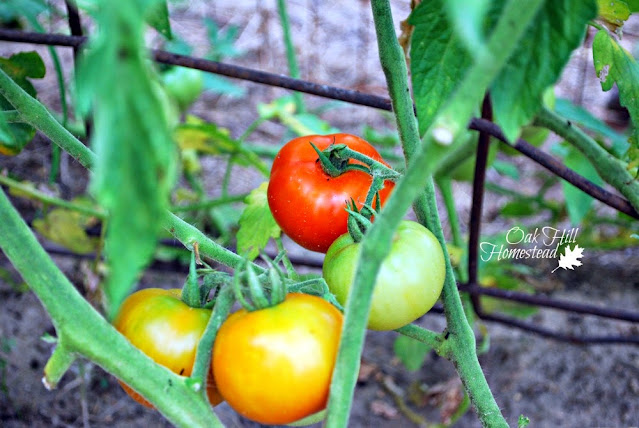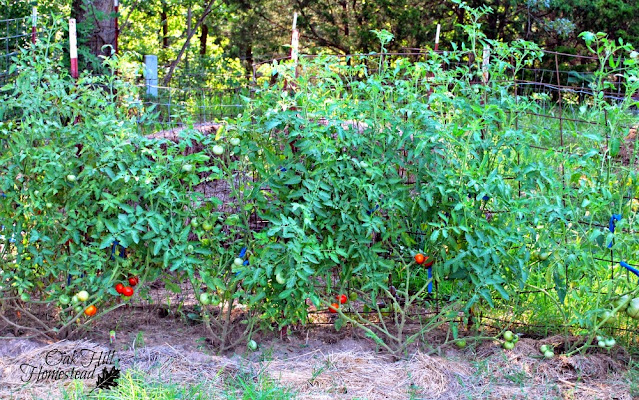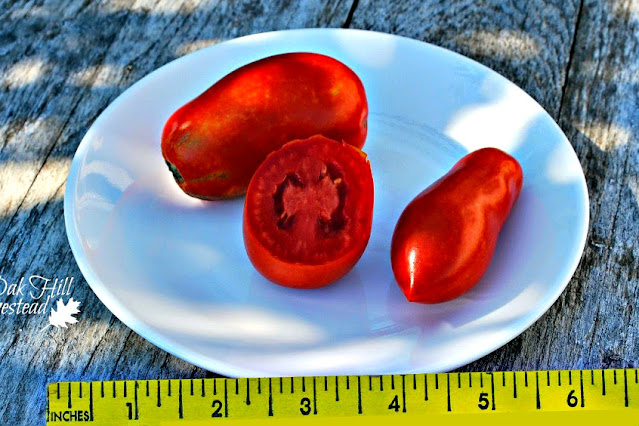Which tomato variety is best for growing in your garden? It depends on your end goal, how to want to use those tomatoes. Learn the difference between determinate and indeterminate tomatoes and the different sizes of tomatoes in this post.
Do you want fresh tomatoes? Do you want to roast them? Top a burger with a huge slice of tomato? Can tomatoes?
Let's explore the many types of tomatoes: determinate and indeterminate, hybrid vs. heirloom, and the six different kinds of tomatoes varieties.
Here's what you need to know to choose the best type of tomatoes for your garden.
Want to listen instead? Here you go!
The different types of tomatoes
Gardening as a hobby and pastime began to really flourish worldwide during 2020 when people were stuck at home, and the interest in gardening hasn’t dropped off.
In fact, there are 71.5 million households that garden, and the trend is still on the rise.
Just so you know, this post may contain affiliate links, which means I receive commissions for purchases made through those links, at no cost to you. You can read my disclosure policy for more info.
Tomatoes are the most popular garden vegetable. Nine out of 10 gardeners grow tomatoes - or try to grow tomatoes.
According to Auburn University, there are more than 10,000 varieties of tomatoes. [Source]
Which are the best tomato varieties to grow? It depends on what you want to do with your tomatoes - whether you want to add them to salads, top sandwiches and burgers, make sauce, or enjoy a snack right in the garden.
The difference between indeterminate and determinate tomatoes
There is a lot of diversity among those 10,000 varieties of tomatoes. Before we even get into the tomato varieties, there are different types or kinds of tomatoes too. Let’s talk about those differences first.
There are two types of tomato plants: determinate and indeterminate.
These two types of tomatoes differ from each other in their growing habits, so I think it’s a good place to start.
Determinate tomato plants
Determinate tomatoes are varieties whose plants grow to a certain size, produce their crop that ripens at relatively the same time, and then they’re done for the season. They won’t produce any more tomatoes after this first crop.
Determinate varieties of tomatoes include paste tomatoes that are grown for making spaghetti sauce, pizza sauce and so on.
If you’re going to can tomatoes, it’s handy to have the crop ready all at the same time instead of having to drag out your equipment and can a batch of tomatoes this week and another batch next week and another two weeks later, right?
The size of determinate tomato plants is easier to control than indeterminate plants, since they grow until their tomatoes are ripe and then they’re pretty much done for the season. They are smaller plants that stay small.
Determinate plants can be grown using wire tomato cages or stakes to keep the plants upright, and can be easily grown in containers too. Determinate tomato plants just don’t get as big as their indeterminate counterparts.
Determinant tomatoes are bush-type plants that stay relatively short compared to indeterminate tomato plants, which are vines that keep growing until frost kills them in the autumn.
Indeterminate tomato plants
Indeterminate plants keep growing all season long and produce tomatoes over a long period of time. The plants just keep growing and growing and growing.
You need a really heavy duty trellis for these plants. They will ruin those tomato cages that you see for sale in stores because they are so vigorous and so top heavy. They’ll eventually topple those cages over from their own weight.
Indeterminate tomato plants are excellent for gardeners who want fresh tomatoes all summer long.
If you are growing tomatoes so you can add them to salads, sandwiches and burgers, you’ll want to choose indeterminate tomato varieties.
An indeterminate variety of tomato will produce more tomatoes over the whole season than a determinate variety that produces fewer tomatoes, but all at once. This is the main difference between the two types of tomato plants.
Which one is right for you depends on what you want to do with the tomatoes.
Click here!
.
Tomato types by size and shape
The next way to categorize tomatoes is by their size and shape.
I’m sure you’ve seen the different sizes of tomatoes in the grocery store. They range from the small tomatoes (cherry and grape) to medium-sized slicing tomatoes or salad tomatoes, up to the monsters, the beefsteak varieties.
There are actually six different kinds of tomatoes if you sort them by their size and shape.
Let’s start with the small ones and move up in size.
Grape tomatoes
Grape tomatoes and cherry tomatoes are the small tomatoes. They come in many shapes including round, oblong and pear-shaped, and in many colors.
The difference between grape and cherry tomatoes
Grape tomatoes have a thicker skin than cherry tomatoes and are meatier (in other words, the inside of the tomato has more “tomato” in it, while a cherry tomato has more juice and seeds and less “meat.”)
Grape tomatoes are bite-sized, usually smaller than a cherry tomato, about ½ inch to ¾ inches long, although there are some that are a bit larger.
They are oblong-shaped and resemble a small watermelon or grape. Grape tomatoes are commonly used for snacking, in salads, on skewers, added to pasta, and roasted with other vegetables.
Their thicker flesh helps grape tomatoes to hold their shape better than other tomatoes when they are grilled, sauteed, etc.
Popular varieties of grape tomatoes include jelly bean and juliette.
Cherry tomatoes
Cherry tomatoes are a bit larger than grape tomatoes, about an inch in diameter. They are sweeter and juicier than grape tomatoes and are best eaten fresh, in salads and as snacks.
 |
| Cherry tomatoes come in many colors, such as yellow, orange, red and purple-red. |
Their skin isn’t as thick so they don’t hold up as well when cooked - but you can still use them instead of grape tomatoes, they just might not be as pretty in the finished dish.
I have to admit that I grow too many cherry tomatoes every year. My young grandson and I like to walk out to the garden and snack on those delicious little tomatoes all summer long.
I grow a variety of colors - red, orange, yellow and a brownish one called Cherry Cola, so everyone in the family can have their favorite flavor.
Pear tomatoes
Pear shaped tomatoes are often classed with the cherry tomatoes because they are similar in size and type, but they can often be slightly larger.
Yellow pear and red pear are the most popular varieties. Just like their name implies, they are pear shaped.
Plum tomatoes
Next in size is the paste or plum tomato.
These tomatoes are larger, about 2 to 2 ½ inches long, and oblong shaped. They are often called paste tomatoes because they are the type of tomato most commonly used to make tomato paste and sauce.
You may have heard of Roma tomatoes before - in fact, sometimes people call all paste tomatoes “Romas,” but the Roma is just one variety of paste tomatoes. There are many others.
Plum tomatoes were developed specifically for the canning industry, and are used to make sauces, ketchup, salsa and so on.
They are meaty tomatoes with thick walls (the outside shell of the tomato, just under the skin) and less juice. These tomatoes cook down quickly because there isn’t as much juice, so they are ideal for canning and preserving.
Although my neighbor likes a sliced plum tomato on his BLT sandwiches. He insists they are the best sandwich tomato.
Paste and plum tomatoes are determinate types, so that the tomatoes all ripen at the same time, making it easy to can and preserve them all at once.
They are also almost always red in color, because who wants a spaghetti sauce that’s yellow? Or orange? Or some weird brownish-colored sauce?
Popular paste or plum tomato varieties are Roma, San Marzano, and Amish Paste.
Slicing or salad tomatoes
Slicing tomatoes are also known as globe tomatoes. These are the medium-sized tomatoes with the classic round shape that we’re all used to seeing in the grocery store.
Slicing tomatoes are approximately 2 to 3 inches in diameter. They range in color from classic red to a rainbow of colors including orange, yellow, pink and purple.
Green Zebra and Mr Stripey are green-striped tomatoes when ripe.
Often slicing tomatoes are cut into wedges for salads, or sliced to go on sandwiches and burgers. They are also tasty in salsas. They are a good all-round tomato in the kitchen.
Early Girl and Better Boy are popular varieties that you’ll probably find as transplants at your local big box stores and garden centers.
Oxheart tomatoes
Similar in size to the plum tomatoes are the oxhearts, but they are a shape unto themselves. They are heart shaped when viewed from the side, resembling a strawberry with a pointed end and a puckered top.
They range in size from 3 to 6 inches in diameter.
Oxhearts have a thick, firm consistency, a very rich flavor and are very fragrant. There are many varieties that range in flavor from sweet to tangy to acidic.
Oxhearts don’t keep well though, a small trade-off for their delicious flavor, but you'll rarely see them in stores for this reason.
Oxheart varieties are indeterminate, and continue to grow and produce all summer long. They tend to have different colors on top and bottom of the fruits, so it can be a little tricky to tell when the tomato is truly ripe.
Besides the original Oxheart variety, many others have been bred and developed. These tomatoes are popular for slicing on sandwiches and burgers, in salsa, and as stuffed tomatoes.
Beefsteak tomatoes
Beefsteak tomatoes are the monsters of the tomato world. They are the largest of all the tomato types, at 3 to 6 inches in diameter and weighing in at up to 64 ounces for just one tomato - that’s 4 pounds.
The heaviest tomato ever recorded was a beefsteak tomato weighing over 11.5 pounds. It had a circumference of 32.5 inches! [Guinness World Records]
Just one slice of a beefsteak tomato will cover the entire slice of bread for your next BLT sandwich.
But they’re not just big, beefsteaks are absolutely delicious. They are meaty and hold their texture well without making the bread soggy.
Beefsteaks are often asymmetrical in shape, with ridges or even resembling pumpkins in shape. They can be prone to cracking on the vine.
These monsters take the longest to mature of all the tomato types, and require the most hours of sunshine as well - up to 13 hours of sun per day.
Beefsteak tomatoes are usually the classic red in color but there are a few options available such as Cherokee Purple and Brandywine pink. A popular variety of red beefsteak tomatoes is the Beefmaster.
Heirloom vs. Hybrid Tomatoes
There are also two distinct types of tomato types: hybrid and heirloom types.
What are heirloom tomatoes?
Heirloom tomatoes are seeds that have been saved for generations, sometimes handed down through a family for many, many years.
These seeds will produce the same tomato variety year after year, and the seeds can be saved and planted again with consistent results.
What are hybrid tomatoes?
Hybrid tomato varieties are usually bred to produce a certain characteristic. A gardener might want to cross two tomato varieties in order to increase disease resistence, or a particular color.
The seeds from these hybrid tomatoes won't produce the same results though. Instead, the next generation of tomatoes will favor one or the other of its "parents."
Read more about hybrid vs heirloom tomatoes here.
My favorite tomato varieties
I tend to go overboard on tomatoes! I grow more than I need to, often at the expense of other vegetables.
I grow so many that there isn't enough room to grow other vegetables that I really should be growing. I'm going to try to do better this year.
Woman cannot live on tomatoes alone - even though it's fun trying!
I've grown a very wide variety of tomatoes over the years. Here is a short list of my favorites (because the long list would need a whole blog post of its own).
Sun Sugar - orange cherry tomatoes, indeterminate, hybrid (open-pollinated)
Black Cherry - a purple-brown cherry tomato, indeterminate, heirloom
Snow White - a yellow/white cherry tomato, indeterminate, heirloom (it's not really white, it's pale yellow)
Yellow Pear - pear-shaped yellow tomatoes the size of cherry tomatoes, indeterminate, heirloom
Amish Paste - red plum tomato, determinant, heirloom
Homestead - red slicing tomato, semi-determinate, heirloom
Mortgage Lifter - red beefsteak tomato, indeterminate, heirloom
Cherokee Purple - purplish-red beefsteak tomato, indeterminate, heirloom
The best variety of tomato for your garden
So which tomato variety should you buy as transplants, or start as seeds? It depends on how you want to use them.
- If you want tomatoes that all turn ripe at one time so you can preserve them, choose a determinate type of tomato. Paste varieties will be best for this use. (Although you can preserve any variety of tomato if you have enough that are ripe at one time!)
- But if you prefer a continuous crop of tomatoes all summer long, grow indeterminate tomatoes.
- Indeterminate tomato plants should be pruned through the season, where determinate tomatoes should not be pruned, so if you don’t want to spend as much time with your tomato plants, determinate types might be a better match for you.
- If you want to save seeds for next year, choose an open-pollinated, heirloom variety for best results and some fun history.
- If you want small tomatoes for fresh snacking by the handful, cherry and grape tomatoes can’t be beat.
- Slicing tomatoes are great for cutting into wedges for salads, and slicing for sandwiches.
- If making fresh salsa is your goal, plum or paste tomatoes are a great choice. They have less juice and hold up well to being chopped.
- Beefsteak is the kind to grow if you like BIG, flavorful tomatoes - one slice will cover your entire burger! They aren't as pretty as smaller tomatos, but they more than make up for it in taste.
Choosing the best tomato varieties for your garden can be an adventure, whether you opt for the unique flavors of heirloom tomatoes, the practical benefits of hybrid varieties, or explore the many varieties available to find the flavors that you love best.
Remember, the "best" tomato is the one that suits your garden, your taste buds, and your culinary needs.
Click here!
.
For more self-sufficient posts like this, subscribe to my weekly-ish newsletter The Acorn, and join me on Facebook, Instagram and Pinterest. I'd love to see you there!
Related Links:
The benefits of growing vegetables vertically (on trellises)
How to root tomato suckers for more tomato plants
Garden vocabulary for beginners





















